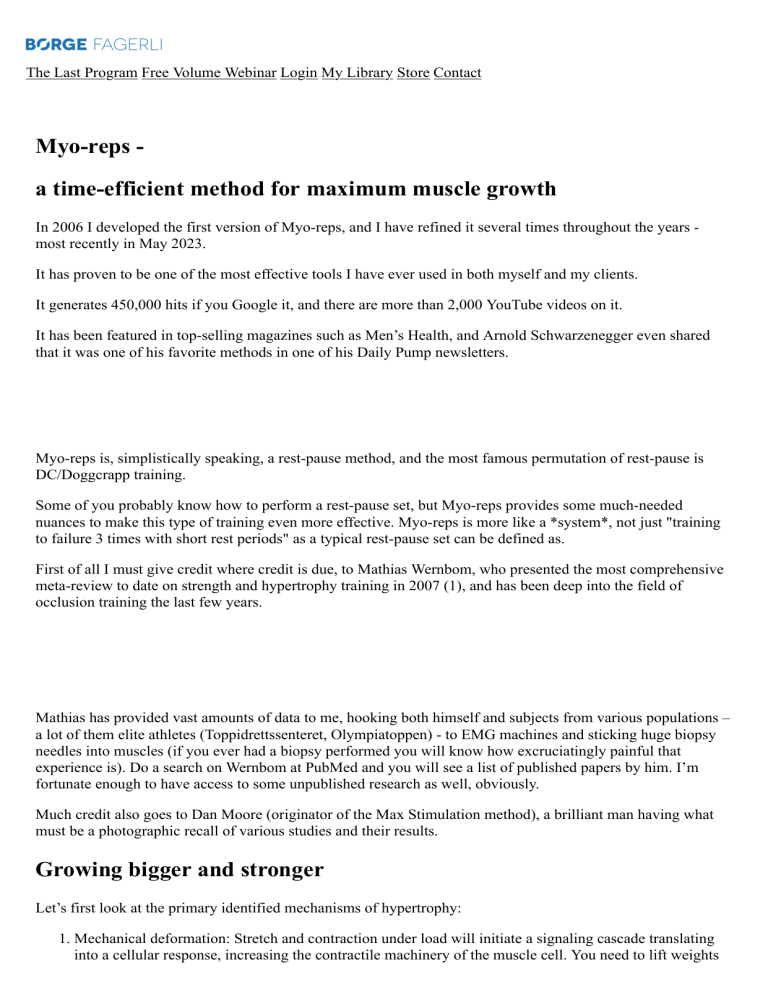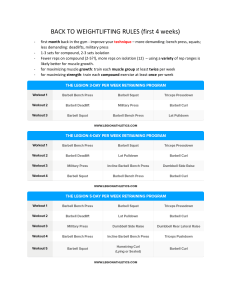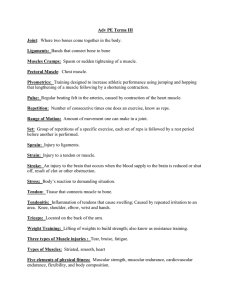
The Last Program Free Volume Webinar Login My Library Store Contact Myo-reps a time-efficient method for maximum muscle growth In 2006 I developed the first version of Myo-reps, and I have refined it several times throughout the years most recently in May 2023. It has proven to be one of the most effective tools I have ever used in both myself and my clients. It generates 450,000 hits if you Google it, and there are more than 2,000 YouTube videos on it. It has been featured in top-selling magazines such as Men’s Health, and Arnold Schwarzenegger even shared that it was one of his favorite methods in one of his Daily Pump newsletters. Myo-reps is, simplistically speaking, a rest-pause method, and the most famous permutation of rest-pause is DC/Doggcrapp training. Some of you probably know how to perform a rest-pause set, but Myo-reps provides some much-needed nuances to make this type of training even more effective. Myo-reps is more like a *system*, not just "training to failure 3 times with short rest periods" as a typical rest-pause set can be defined as. First of all I must give credit where credit is due, to Mathias Wernbom, who presented the most comprehensive meta-review to date on strength and hypertrophy training in 2007 (1), and has been deep into the field of occlusion training the last few years. Mathias has provided vast amounts of data to me, hooking both himself and subjects from various populations – a lot of them elite athletes (Toppidrettssenteret, Olympiatoppen) - to EMG machines and sticking huge biopsy needles into muscles (if you ever had a biopsy performed you will know how excruciatingly painful that experience is). Do a search on Wernbom at PubMed and you will see a list of published papers by him. I’m fortunate enough to have access to some unpublished research as well, obviously. Much credit also goes to Dan Moore (originator of the Max Stimulation method), a brilliant man having what must be a photographic recall of various studies and their results. Growing bigger and stronger Let’s first look at the primary identified mechanisms of hypertrophy: 1. Mechanical deformation: Stretch and contraction under load will initiate a signaling cascade translating into a cellular response, increasing the contractile machinery of the muscle cell. You need to lift weights to grow. Fundamental stuff, indeed. 2. Motor unit and muscle fiber recruitment: The research is pretty clear on the fact that you eventually need to recruit most of/all of the motor units and muscle fibers in a muscle to stimulate maximum muscle growth. 1. At approx. 80%+ of 1RM (about 5-8RM loads) you are pretty much at 100% fiber recruitment from the very first rep. For loads heavier than 5RM, use cluster training - sets of 1-3 reps with 30-60sec rest in between. 2. At lighter loads, you won’t recruit all muscle fibers from the beginning, but as you fatigue you will have to call upon more muscle fibers to complete the set. The last few reps of a set will achieve 100% fiber recruitment, so e.g. a 12RM set has approx. 5 “effective” (a phrase I coined in 2006) or *stimulating" reps at the very end. See the illustration below to understand this better. Also, I’m not saying that the first reps are ineffective, they are needed to accumulate sufficient fatigue to reach all fibers of the muscle. There has been a lot of research into occlusion-type training where dramatic hypertrophy is observed even with very light loads (20-50% of 1RM) just by tying a blood pressure cuff around an arm or a leg. The main mechanism seems to be an earlier full fiber recruitment effect from the hypoxia (oxygen deprivation) created from occluding the blood flow. Research by some of the most renowned scientists in the field (2) has shown that lifting 30% loads to failure induced the same muscle growth as 80-90% loads to failure. 3. You will also achieve full recruitment transiently by lifting a light load as fast as possible, but only in the turn-around phase from the eccentric to the concentric phase and in the early part of the rep when the weight is still accelerating. By using elastic bands or chains you may increase this acceleration phase by having to push harder vs. slowing down as leverages usually improves at the top of e.g. deadlifts, bench press and squats. 4. Metabolic stress, calcium flux and volume: The muscle has to perform a minimum threshold of work with the imposed load and mechanical tension. Reps and the work:rest ratio sets the metabolic state of the muscle. Short duration high-amplitude pulses of calcium into the muscle by high load contractions and rest between sets induced muscle hypertrophy, longer duration low-amplitude pulses such as in cycling or running induces endurance adaptions. Metabolic stress and volume is said to “modulate” the hypertrophic response, i.e. the load is the primary variable, the sets and reps determines the magnitude and duration of the muscle growth you will get out of it. Some caveats: 1. Metabolic stress increases the supply of energy substrates to the muscle, i.e. glycogen stores, blood flow, oxygenation, capillarization, mitochondrial function, and also challenges the cardiovascular component of the heart and lungs. But it is NOT a driver of muscle growth, it’s a byproduct of the training needed to achieve muscle growth 2. If you overdo it, you increase AMPK – one of the primary energy-sensors of the cell – and this can inhibit protein synthesis and initiate endurance adaptions. This is why extensive interval training (20+ minutes of sprints with short rest, Tabatas with a 2:1 work to rest ratio etc) doesn’t necessarily lead to massive muscle growth – excessive metabolic stress and calcium flux combined with depletion of energy substrates turns on endurance and turns off muscle growth. So we need to do lower volumes of work for maximum stimulus:fatigue ratio - and this is where Myo-reps has a few interesting benefits. 3. Hormones and amino acids - testosterone, GH/IGF-1, insulin, cortisol, protein. Some more important than others, and the hormones seem to play more of a permissive effect in muscle growth, but ultimately determines (along with your genetic makeup) how big and strong you can get. Getting hung-up on transient elevations from what you eat or how you train is pretty much irrelevant and more of a correlative than a causative effect. Amino acids and nutrients in general are mandatory as they provide building blocks for muscle growth. However, the body is very good at recycling them which is why you can grow muscle even under fasting conditions. Two things to note here: 1. Kaatsu (blood flow occlusion by pressure cuffs) increases the EMG signal and fiber recruitment, but the main mechanism is the last few repetitions slowing down to the point where mechanical tension is allowed to do its job on the high threshold muscle fibers. 2. After the first set and a short rest period, you maintain the fiber recruitment and CONTINUE applying the mechanical tension. This forms the basis for Myo-reps. (illustration from (4)) - you are *extending* the set with "effective" reps (high activation + high mechanical tension). The Myo-reps set from start to finish We basically need to lift a sufficiently heavy load, for a sufficient number of sets and reps, sufficiently often to build muscle at the optimal rate. There are many ways of achieving this, and Myo-reps is simply a very effective tool. I rarely do straight sets anymore unless it’s a single set. Let’s see how you perform a Myo-rep set from beginning to end. I recommend 2 warm-up sets of progressively increasing loads of 5-8 reps and 3-5 reps, respectively prior to the work set. This will increase neural drive and also let you determine your daily strength level and hence, work set load. 1. Pick a load you can perform 5-12 reps with (up to 20 reps, but higher reps are more fatiguing so should probably only be used for 1-2 weeks at a time and/or for rehabilitation purposes). 2. Go to 1-2 reps short of failure (1-2RIR), judged by when rep speed slows noticeably. If you don’t know your failure point, you should spend at least 2 weeks or more doing 1 set to failure only, and then increase your volume by doing Myo-reps and switching to a 1-2RIR strategy. This is your “activation set” where you achieve full fiber recruitment. Total failure isn’t an absolute requirement, might increase fatigue excessively - and leaving a rep or two in the tank will allow you to do more total reps. 3. There can be value in keeping constant tension on the muscle, i.e. shorten the ROM by 10% on top (avoid locking out the weight) and avoiding the 10% in the bottom (resting the weight or overstretching the muscle). Most muscles respond better to the mid-range of the ROM (lats, delts, biceps, triceps, hamstrings), and a lot of research even indicates that partial ROM training can be more effective than full ROM. Some muscle groups get better gains from lengthened ROM (quads, pecs and calves) whereas glutes respond better to shortened (hip thrusts and glute bridges). 4. Now the important part – rerack the weight and rest for 3-5, up to 10 deep breaths – unrack the weight and keep going for up to 2-5 short mini-sets of 2-4 reps (staying at the same 1-2RIR on each mini-set but going to failure on the final mini-set is allowed). By regulating the rest period to manage fatigue levels you will get in the most “effective” reps for the least amount of fatigue - this type of training is quite fatiguing in and of itself. You can do the higher end (10 deep breaths/30secs) with heavier loads, but at lighter loads you should keep rest periods short (3-5 breaths/10-15secs) to maintain high fiber recruitment. It is also productive on the Myo-rep series to keep constant tension on the muscle by shortening the ROM. 5. End the Myo-rep set when you approach failure OR lose 1 rep from the initial OR 5 mini-sets. Examples (all correct): 12 +4+4+3 8 +3+3+3+3+3 6 +2+1 Incorrect: 12 +4+4+4+3+3 (stop when you lose a rep from the initial) 8 +3+3+3+3+3+3+3+3+3 (stop at 5 sets of 3 reps) 6 +2+1+1+1 (same as the first one, stop when you lose a rep from the initial) Let’s illustrate the difference between a “traditional” 3 sets of 10 vs. a Myo-rep set, the asterisk ‘*’ denoting “effective” reps: 1 2 3 4 5* 6* 7* 8* 9* 10* 1-2min of rest 1 2 3 4 5* 6* 7* 8* 9* (a typical drop off in reps if using a 10RM load) 1-2min of rest 1 2 3 4* 5* 6* 7* 8* So you did 27 total reps in about 6 minutes, where 15 reps were “effective” reps (at sufficiently high fiber recruitment). Now a Myo-rep set: 1 2 3 4 5* 6* 7* 8* 9* (1RIR) - 15sec rest - 1* 2* 3* 4* - 15sec rest - 1* 2* 3* 4*- 15sec rest - 1* 2* 3* Here you did 20 total reps in about 1.5-2 minutes, where 15 reps were “effective”. So 70% less time, 30% less overall volume, and the same results. Here’s a demonstration of a full Myo-rep set (7+2+2): Auto-regulating your way to better results There are two ways of managing volume here. First, you can prescribe a total number of reps/sets for an exercise. So in place of 2 normal sets, you can do +2+2 or +3+2 or +3+3 for the Myo-rep sets. In place of 3 normal sets, you can do +2+2+2+2 or +3+2+2+2 or +3+3+2+2 or +3+3+3 or +3+3+3+3 etc etc Some might find the fatigue LESS from a Myo-rep set than traditional sets since you don’t have to - and probably shouldn’t - go to failure. You can also use auto-regulation where you let the total volume (number of reps) take care of itself based on how you feel that day - your individual recovery level. Example protocols: 5-8 +1-3x 8-12 +3-4x 12-15 +3-4x 15-20 +3-5x The first part (e.g. 8-12) denotes reps in the activation set, the number after the + is how many reps you will do in the Myo-reps mini-series. So 8-12 +3-4x may look like this: 200lbs x10 +3+3+3+3+2 – you weren’t able to do the third rep of the last set so you stop there Here’s how auto-regulation works: Let’s say you had a good night’s sleep, ate well, had a day off from work, and generally feel great and wellrecovered. The 12-15 +3-5x protocol would most likely turn out like this: 200lbs x 12 +4+4+4+4+4 Now, let’s say you had a couple of drinks too many at your brother’s bachelor party last night, your girlfriend broke up with you because you fondled the stripper, the neighbour’s cat kept you awake, and you’ve been dieting for 3 months. The same protocol would most likely deteriorate to this: 200lbs x 8 +3+2 Doing less work when your recovery and adaptive reserves are compromised makes logical and practical sense, and you will most likely come back stronger the next time (provided you stay sober, stop dieting, kiss and make up with your girlfriend – or the stripper if she was really hot) vs. struggling to do the same amount of work you had planned to, or even more by adding sets and dropsets to punish yourself for being such a failure as a human being. Stimulate, don’t annihilate as the great Lee Haney said. You will also note that various muscle groups and exercises have different recovery rates and volume tolerances, so if you consistently get something like 8 +3+2 you can try longer rests (10 deep breaths), if you consistently get 15 +5+5+5+5+5 and feel like you could have kept going forever, use shorter rests (1-2 deep breaths). Note that you can also do more reps in the Myo-rep series by doing short ROM partial reps as mentioned earlier. The Myo-reps study In 2022, a team of researchers at University of Tampa, Florida compared 1 Myo-rep set to 3 normal sets, and confirmed that the muscle growth was the exact same - even though the subjects spent 70% less time and did 30% less reps. Here’s lead researcher Joshua Bradshaw from his poster presentation at the NSCA conference. The full study will be officially published (peer-review process can be tedious) some time during 2023. Also see the illustration of the results below (the study was repeated later with a larger subject pool, confirming previous results). You may notice that the Myo-reps group even seemed to have a larger overall effect, but they also started at a lower muscle mass: What exercises? I won’t go much into detail on exercise selection and template structure, there are many ways of programming your training strategy. In a full-body program, you only do 1 exercise per muscle group, other types of splits (upper/lower, push/pull, push/pull/legs) you will do 2-3 exercises. Dumbbell presses are less suitable for Myo-reps, as it requires a lot of energy to get them into position and stabilize them. Having only a few seconds of rest makes you run out of breath before you get the load to do sufficient work on the muscles. I’m also careful with Myo-reps on squats, deadlifts, and even bent rows as the accumulating fatigue in the lower back may compromise technique and increase injury potential. Concluding remarks As you can see, a Myo-rep set takes advantage of the primary mechanisms of muscle growth - mechanical load, increasing fiber recruitment and maintaining it at a high level to get more “effective” reps, increasing the muscle sensitivity to the growth stimulus via metabolic stress, modulated by the volume effect (total sets and reps) and doing more work in less time. With Myo-reps you can get in and out of the gym in 30 minutes if you are short on time, you can provide a different stimulus to a muscle group from the “traditional” way of structuring sets and reps, and it can potentially provide better results. Myo-reps is a great tool to have in your toolbox in the quest for a massive and strong physique, feel free to play around with it and let me know if you have any questions or comments. Hate mail due to severe soreness is also more than welcome. Borge A. Fagerli coach@borgefagerli.com References: 1. Wernbom M, Augustsson J, Thomeé R., The influence of frequency, intensity, volume and mode of strength training on whole muscle cross-sectional area in humans., Sports Med. 2007;37(3):225-64. 2. Burd NA, West DW, Staples AW, Atherton PJ, Baker JM, Moore DR, Holwerda AM, Parise G, Rennie MJ, Baker SK, Phillips SM., Low-load high volume resistance exercise stimulates muscle protein synthesis more than high-load low volume resistance exercise in young men., PLoS One. 2010 Aug 9;5(8):e12033. PMID: 20711498 3. Baar K., The signaling underlying FITness., Appl Physiol Nutr Metab. 2009 Jun;34(3):411-9. 4. Yasuda T, Fujita S, Ogasawara R, Sato Y, Abe T., Effects of low-intensity bench press training with restricted arm muscle blood flow on chest muscle hypertrophy: a pilot study., Clin Physiol Funct Imaging. 2010 Sep;30(5):338-43. Epub 2010 Jul 4. The Last Program you’ll ever need to invest in The culmination of 25 years of experience, thousands of pages of professional literature and studies, and the results of nearly 4,000 client cases summarized in one program - the most effective principles and methods gathered in one place! Learn More



